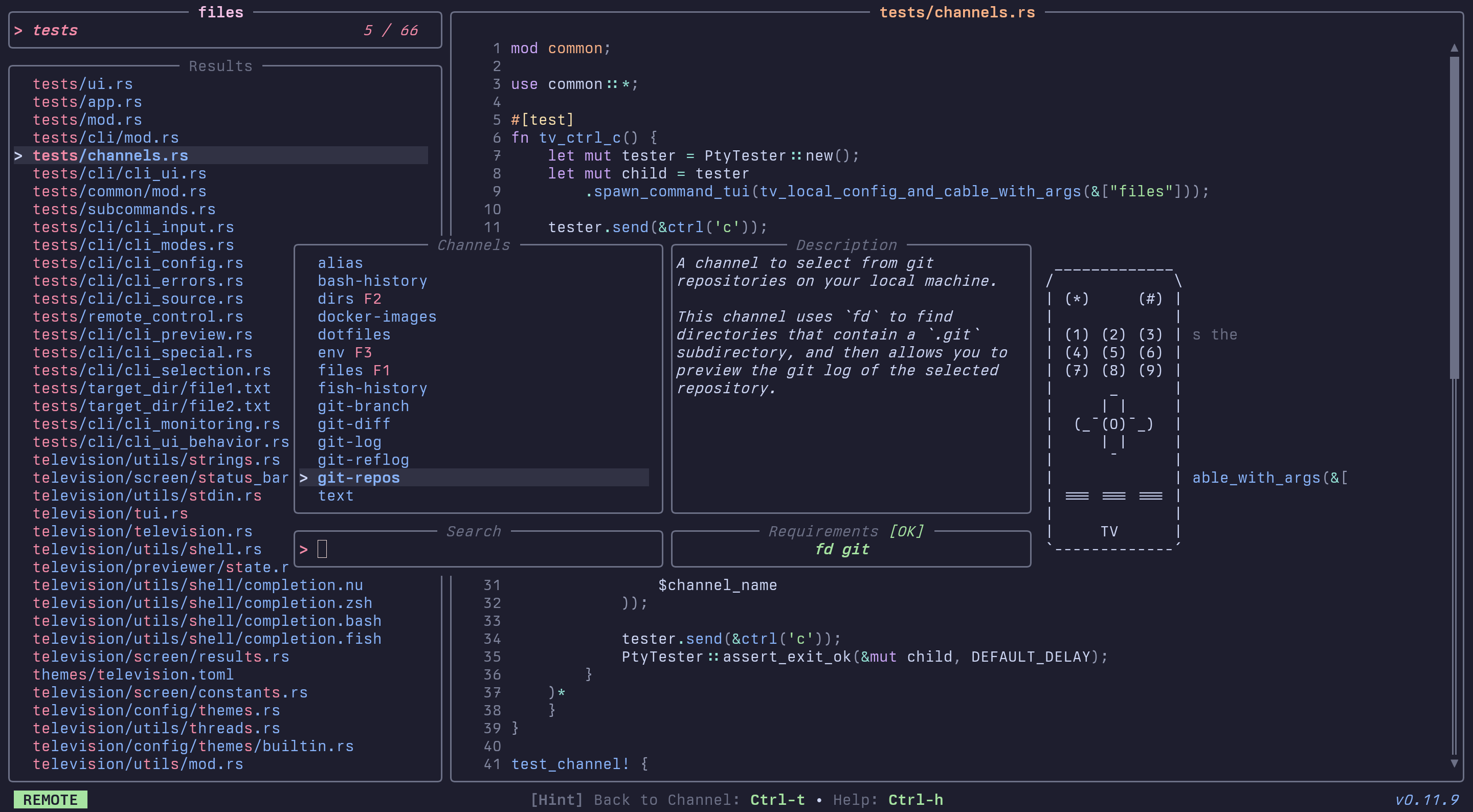Channels
Quick start
Channels are short configuration recipes that typically dictate what tv should search through and what's displayed on the screen along with various other options.
Any given channel consists of a single TOML file.
Example: the default files channel
[metadata]
name = "files"
description = "A channel to select files and directories"
requirements = ["fd", "bat"]
[source]
command = "fd -t f"
[preview]
command = "bat -n --color=always '{}'"
env = { BAT_THEME = "ansi" }
[keybindings]
shortcut = "f1"
Default location on your system
Channels live in the cable directory inside your television configuration directory.
Example:
/home/user/.config/television
├── config.toml
└── cable
├── files.toml
├── env.toml
├── alias.toml
├── git-repos.toml
└── text.toml
Community-maintained channels
The repository hosts a list of community-maintained channels which you can get and install to your cable directory using:
tv update-channels
Invocation
Channels may be invoked:
- directly from the cli:
tv files
-
using the remote control:

-
on the fly:
tv --source-command 'fd -t f .' --preview-command 'bat -n --color=always {}' --preview-size 70
Creating your own channels
Create a new TOML file in your cable directory:
touch ~/.config/television/cable/my-awesome-channel.toml
Fill out the minimum required fields:
[metadata]
name = "my-awesome-channel"
[source]
command = "aws s3 ls my-bucket"
Launch tv with your new channel (or select it via the remote control):
tv my-awesome-channel
The complete channel format spec can be found below.
Templating syntax
Several channel fields can be formatted dynamically using the syntax described in the string-pipeline crate.
Here's a quick TLDR if you're feeling lazy:
Basic transformations:
# Extract middle items: "a,b,c,d,e"
"{split:,:1..3}"
# Output: "b,c"
# Clean and format names: " john , jane , bob "
'{split:,:..|map:{trim|upper|append:!}}'
# Output: "JOHN!,JANE!,BOB!"
# Extract numbers and pad with zeros: "item1,thing22,stuff333"
'{split:,:..|map:{regex_extract:\d+|pad:3:0:left}}'
# Output: "001,022,333"
More niche use-cases:
# Filter files, format as list: "app.py,readme.md,test.py,data.json"
'{split:,:..|filter:\.py$|sort|map:{prepend:• }|join:\n}'
# Output: "• app.py\n• test.py"
# Extract domains from URLs: "https://github.com,https://google.com"
'{split:,:..|map:{regex_extract://([^/]+):1|upper}}'
# Output: "GITHUB.COM,GOOGLE.COM"
# Debug complex processing: "apple Banana cherry Date"
"{split: :..|filter:^[A-Z]|sort:desc}"
# Output: Date,Banana
Channel specification
high-level sections
[metadata]
# general channel information
[source]
# this defines what we're searching through
[preview]
# for each result, maybe display a preview
[ui]
# customize the UI
[keybindings]
# customize keybindings
[metadata]
[metadata]
name = "text"
description = "A short description about what my channel does"
requirements = ["rg", "bat"] # any binary requirements my channel needs
[source]
[source]
command = "rg . --no-heading --line-number --colors 'match:fg:white' --colors 'path:fg:blue' --color=always"
# display = "[{split:\\::..2}]\t{split:\\::2}" # what's displayed in the UI (incompatible with `ansi = true`)
output = "{strip_ansi|split:\\::..2}"
ansi = true # whether the results are ANSI formatted
[preview]
[preview]
command = 'bat -n --color=always {split:\::0}'
env = { BAT_THEME = "ansi" } # extra envs to use when generating preview
offset = '{split:\::1}' # extracts preview offset information from the entry
[ui]
[ui]
ui_scale = 80 # use 80% of available screen
layout = "portrait"
input_bar_position = "bottom"
input_header = "Search:"
[ui.preview_panel]
size = 40 # 40%
header = "{}" # show the currently selected entry
footer = "my awesome footer"
scrollbar = false
[ui.status_bar]
separator_open = "<"
separator_close = ">"
[ui.help_panel]
show_categories = true
[ui.remote_control]
show_channel_descriptions = true
sort_alphabetically = true
# UI panel visibility (individual control)
[ui.preview_panel]
hidden = false
[ui.status_bar]
hidden = false
[ui.help_panel]
hidden = true
[ui.remote_control]
# disabled = false # uncomment to disable remote control for this channel
[keybindings]
[keybindings]
shortcut = "f1" # `f1` will automatically switch to this channel
quit = ["esc", "ctrl-c"]
select_next_entry = "ctrl-j"
select_prev_entry = "ctrl-k"
confirm_selection = "ctrl-y"
See actions.rs for a list of available actions.
[actions]
External actions allow you to define custom commands that can be executed on
selected entries. Actions are triggered via keybindings using the
actions:<action_name> syntax.
Simple Braces Syntactic Sugar:
For most use cases, you can use simple {} braces which automatically handle
quoting and multiple entries:
[actions.edit]
description = "Open selected files in editor"
command = "nvim {}"
# Single file: nvim 'file1.txt'
# Multiple files: nvim 'file1.txt' 'file2.txt'
# Files with quotes: nvim 'file\'s name.txt'
Advanced Template Processing:
For complex formatting needs, use the full templating syntax:
[keybindings]
ctrl-e = "actions:edit"
f2 = "actions:view"
[actions.edit]
description = "Open selected files in editor"
command = "nvim {split:\\n:..|map:{append:'|prepend:'}|join: }"
mode = "execute"
separator = "\n"
# example: inputs "file1" and "file 2" will generate the command
# nvim 'file1' 'file 2'
# Note: we added quotes at command level to avoid shell artifacts
[actions.view]
description = "View files with less"
command = "less {}"
mode = "fork"
separator = " "
# example: inputs "file1" and "file 2" will generate the command
# less file1 file 2
# Note: 3 args here, instead of 2
Action specification:
description- Optional description of what the action doescommand- Command template to execute (supports templating syntax)mode- Execution mode:execute- Run command and become the new processfork- Run command in a subprocess, allowing you to return to tv upon completion
separator- Character(s) to use when joining multiple selected entries when using complex template processing, depending on the entries content it might be beneficial to change to another one (default:" "- space)